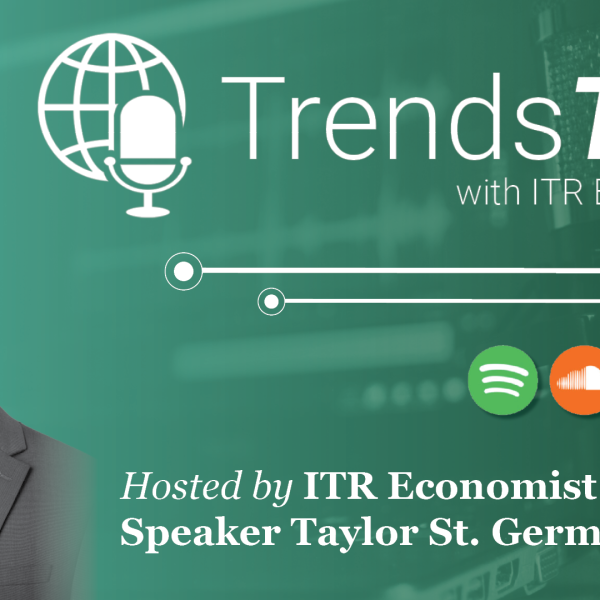- Mon - Fri: 8:30 - 5:00
- +1-603-796-2500
- ITR@itreconomics.com
February 3, 2023
- Home
- portfolio
- TrendsTalk
- February 3, 2023
with connor lokar
PORT TRAFFIC TRENDS
As the economy progresses through the back side of the business cycle, learn about the latest port traffic trends in the latest episode of TrendsTalk with ITR Economics Senior Forecaster Connor Lokar.
The below transcript is a literal translation of the podcast audio that has been machine generated by Rev.
Hello, everyone. Connor Lokar, ITR Senior Forecaster here for another TrendsTalk. And today we’re talking tea leaves, specifically reading the US Port traffic trends. Now, there’s a chart that myself and other keynote presenters at ITR, we occasionally use it on the road, I started to use it a little bit more lately, that shows total intermodal container traffic. Essentially, how many containers are we pulling through US ports here, whether it’s east, west or Gulf Coast ports? And right now, they are telegraphing, ongoing slowdown that we are seeing, we’ve been forecasting and we expect to continue for the US economy.
Now, I feel like it was just yesterday that the narrative being pushed on is day and night. Day and night was about the overwhelmed US ports, ships stacked up as far as the eyes can see, and then even when the containers got off the ships, getting them inland took weeks if not months. But if you pause for a moment, you might notice that we haven’t really heard a lot about that lately. That’s because port pressure is officially, and in some cases precipitously, easing around the United States, and that’s generally not a great sign. So container traffic, which is a volume measure, and I love that very much these days as it takes the inflation masking out of the equation, is falling in the five major US ports that we look at in that particular chart, in Los Angeles, Long Beach, Houston, New York, New Jersey, and Georgia.
Now, the worst of it is occurring in LA and Long Beach. And your initial temptation’s probably to explain that away because the West Coast issues have been stemming to ongoing labor negotiations there since last year, which I’ll concede, happily. But many of those imports, part of the reason it’s down so much is they have rerouted those to our other ports. And if our import consumption was really robust on a volume basis on a hold, then we would see that the LA and Long Beach declines more than made up for the other ports. And we’re not. We are still seeing declines in the Gulf. We are still seeing declines on the East Coast, again, not as bad, but still falling, with the support of those rerouted containers.
So I think this is further supported by, really, the underwhelming inflation adjusted retail numbers that we saw in November and December of 2022, which did come in below their respective months in 2021 on a month over month basis. Now, they weren’t disastrous numbers, which the media tried to tell you, but they weren’t necessarily stellar either. And to top it all off, container rates have [inaudible 00:02:35]. So the Dry Baltic Index, which is an index of global freight rates for shipping dry commodities, things like iron ore, coal, grain, stuff like that, has fallen dramatically since peaking during the consumption surge in 2021, 2022. In fact, the raw index value, again, a rate number for December 2022, has fallen so far that it’s just 8.4% above the 2019 average for the year as a whole. A year I picked because that’s the last full calendar year of the pre-COVID times.
So we should listen to what the container traffic tea leaves are telling us. Container traffic and container rates started to roar higher as early as the second half of 2020, really serving as a precursor for the aggregate inflation and supply chain goals that really came to define our lives for 2021 and last year in 2022, and I think they’re equally as important now as we progress through the backside of the business cycle. They’re telling us exactly what ITR’S been forecasting, that the economy’s slowing down, that inflation and supply chain are set to improve further as the year progresses, and really, the volume of express growth where a lot of folks is going to feel pressure here in 2023. So are you paying attention and are you prepared? Something to think about. Thanks for stopping by. See you on the next one.





